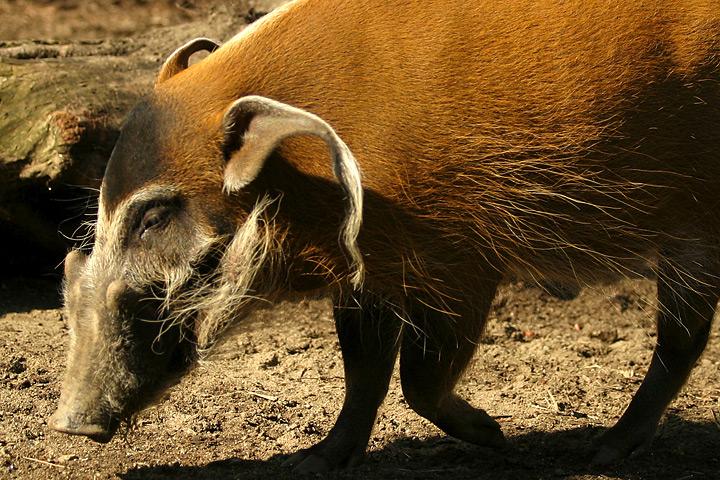- Suidae
Taxobox
name = Suidae

image_caption = "Potamochoerus porcus "
regnum =Animal ia
phylum = Chordata
classis =Mammal ia
ordo =Artiodactyla
familia = Suidae
familia_authority = Gray, 1821
subdivision_ranks = Genera
subdivision =Babirusa s, "Babyrousa"Giant forest hog s, "Hylochoerus"Warthog s, "Phacochoerus"Pygmy Hog , "Porcula"Bushpig s, "Potamochoerus"Pig s, "Sus"Suidae is the biological family to which
pig s and their relatives belong. Up to sixteen species are currently recognised, including the domestic pig "Sus scrofa" or "S. domesticus". They are classified into between four and eight genera. In addition to numerous species of wild pig, the family includes thebabirusa "Babyrousa babyrussa" and thewarthog "Phacochoerus aethiopicus". All of the species are found in theOld World , ranging from Asia and its islands, to Europe, and Africa.The earliest fossil suids date from the
Oligocene epoch of Asia, and their descendants reached Europe during theMiocene [cite book |editor=Palmer, D.|year=1999 |title= The Marshall Illustrated Encyclopedia of Dinosaurs and Prehistoric Animals|publisher= Marshall Editions|location=London|pages= 269|isbn= 1-84028-152-9] . Several fossil species are known, and show adaptations to a wide range of different diets, from strict herbivory to possible carrion-eating (in "Toconodon").cite book |author= Savage, RJG, & Long, MR|year=1986 |title= Mammal Evolution: an illustrated guide|publisher= Facts on File|location=New York|pages= 212-213|isbn= 0-8160-1194-X]Physical characteristics
Suids belong to the order
Artiodactyla , and are generally regarded as the living members of that order most similar to the ancestral form. Unlike most other members of the order, they have four toes on each foot, although they walk only on the middle two digits, with the others staying clear of the ground. They also have a simple stomach, rather than the more complex,ruminant , stomach found in most other Artiodactyl families.cite book |editor=Macdonald, D.|author= Cumming, David|year=1984 |title= The Encyclopedia of Mammals|publisher= Facts on File|location=New York|pages= 500-503|isbn= 0-87196-871-1]They are small to medium animals, varying in size from 58 to 66cm in length, and 6-9 kg in weight in the case of the
Pygmy Hog , to 130-210 cm and 130-275 kg in theGiant Forest Hog . They have large heads and short necks, with relatively small eyes and prominent ears. Their heads have a distinctive snout, ending in a disc-shaped nose. Suids typically have a bristly coat, and a short tail ending in a tassle. The males possess acorkscrew -shapedpenis , which fits into a similarly shaped groove in the female'scervix .Suids have a well developed sense of hearing, and are vocal animals, communicating with a series of grunts, squeals, and similar sounds. They also have an acute sense of smell. Many species are omnivorous, eating grass, leaves, roots, insects, worms, and even frogs or mice. Other species, such as the
warthog , are more selective and purely herbivorous.Their teeth reflect their diet, and suids retain the upper
incisor s, which are lost in most other Artiodactyls. The canine teeth are enlarged to form prominent tusks, used for rooting in moist earth or undergrowth, and in fighting. They have only a short diastema. The number of teeth varies between species, but the general dental formula is:Behaviour and reproduction
Despite their apparently 'primitive' anatomy, suids are intelligent and adaptable animals. Adult females travel in groups called sounders, together with their young, whilst adult males are either solitary, or travel in small bachelor groups. They are generally not territorial animals, and come into conflict only during the mating season.
Litter size varies between one and twelve, depending on the species. The mother prepares a grass nest or similar den, which the young leave after about ten days. Suids are weaned at around three months, and become sexually mature at 18 months. In practice, however, male suids are unlikely to gain access to sows in the wild until they have reached their full physical size, at around four years of age. In all species, the male is significantly larger than the female, and possesses more prominent tusks.
Classification
The complete list of living species, and a partial list of fossil genera, follows:
*"
Babyrousa "
**"Babyrousa babyrussa"Babirusa , pig-deer; Indonesia
*"Chleuastochoerus "†
*"Conohyus "†
*"Hylochoerus "
**"Hylochoerus meinertzhageni"Giant Forest Hog ; Equatorial Africa
*"Kubanochoerus "†
*"Listriodon "†
*"Metridiochoerus "†
*"Microstonyx "†
*"Phacochoerus "
**"Phacochoerus aethiopicus" Cape, Somali or Desert Warthog; West, East and southern Africa
**"Phacochoerus africanus" Common Warthog
*"Porcula "
**"Porcula salvania"Pygmy Hog ; NE India, Himalayas
*"Potamochoerus "
**"Potamochoerus larvatus"Bushpig
**"Potamochoerus porcus"Red River Hog ; Africa south of the Sahara
*"Sus "
**"Sus ahoenobarbus"Palawan Pig
**"Sus barbatus"Bearded Pig ; Malaysia, Indonesia
**"Sus bucculentus"Vietnamese Warty Pig
**"Sus cebifrons"Visasyas Warty Pig
**"Sus celebensis"Celebes Warty Pig
**"Sus heureni"Flores Warty Pig
**"Sus oliveri"Oliver's Warty Pig
**"Sus philippensis" Philippine Warty Pig
**"Sus scrofa" (also called "S. domesticus")Domestic pig ,wild boar ; Europe, Asia
**"Sus timoriensis"Timor Warty Pig
**"Sus verrucosus"Javan Warty Pig ; Indonesia, Philippines
*"Toconodon "†See also
*
Wild Pigs of the Philippines References
Wikimedia Foundation. 2010.
